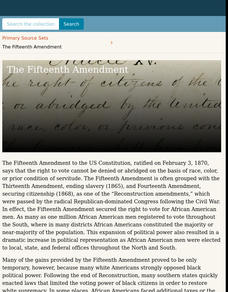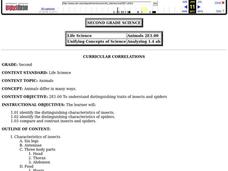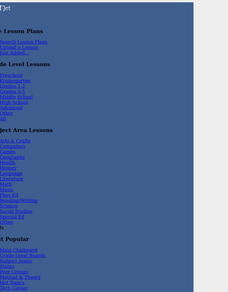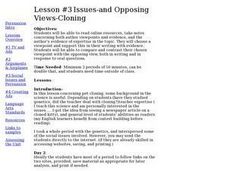Brine Shrimp: Getting to Know a Salt Water Arthropod
Gather small observations of arthropods. Using brine shrimp, pupils observe the life cycle of arthropods. Learners set up saltwater aquariums and observe the brine shrimp over a three-week period. To finish, they compare and contrast how...
Concord Consortium
Square-Ness
Are there some rectangles that are more square than others? A thought-provoking task asks individuals to create a formula that objectifies the square-ness of a set of rectangles. They then use their formulas to rank a set of rectangles.
Digital Public Library of America
The Fifteenth Amendment
Fifteen primary sources provide a context for a study of the Fifteenth Amendment to the United States Constitution. The packet captures the excitement for the changes promised by the amendment as well as the backlash against it.
Digital Public Library of America
Fannie Lou Hamer and the Civil Rights Movement in Rural Mississippi
Good primary resources, offering different perspectives on important issues and events, are hard to find. A packet of 12 primary source images, videos, audio recordings, records, and newspaper articles related to the 1960s civil rights...
San Antonio Independent School District
Ancient Civilizations
Here is a fantastic set of graphic organizers to accompany your study of civilizations such as ancient Egypt, Sumer, Assyria, and Persia.
Science Matters
Photosynthesis-Cellular Respiration Cycle
The balance of nature can be a wondrous thing! With the 19th lesson of the 21-part series on systems, learners explore the cycle of photosynthesis and cellular respiration using a lab-based activity. Groups set up different test tubes...
Facing History and Ourselves
Free Press Makes Democracy Work
A unit study of the importance of a free press in a democracy begins with class members listening to a podcast featuring two journalists, one from a United States public radio station and one from Capetown, South Africa. The lesson plan,...
University of Colorado
Using a Fancy Spectrograph
Put the spectrograph to good use. Using a spectrograph individuals built themselves, young scientists examine and record the emission spectra of different light sources. They use the spectra to compare and contrast the compositions of...
American Chemical Society
Liquids Have Properties
Liquids have many similarities, but their differences can set them apart. Using a student activity guide, learners conduct different property tests on water, oil, and syrup. They record their results and use them to rank the liquids by...
Newseum
Persuasion Portfolios
After class members brainstorm a list of current social and political issues, groups each select a different topic from the list to research. Teams create a portfolio of at least 10 examples of stories about their issue, stories that...
Curated OER
Animals
Second graders explore the ways in which animals differ. They discuss the characteristics of insects and spiders. Students identify the characteristics of insects and spiders. They compare and contrast insects and spiders.
Curated OER
Are You a Frog?
Students listen to the book "Ask Me If I'm a Frog, and compare their anatomy and habits to the anatomy and habits of a frog to identify with the characteristics unique to frogs. They respond to teacher-generated questions by writing...
Curated OER
Understanding the Layers of the Earth
Fourth graders explore the three layers of the Earth describing the composition, thickness, and temperature of each layer. Layers are compared and contrasted and data unearthed placed into graphic organizers.
Curated OER
Time in a Teakettle
Students compare and contrast the development of teakettles. In this artifacts lesson, students divide into groups and examine different teakettles. Students complete an artifact analysis worksheet, draw a picture of their kettle and...
Curated OER
Three Little Pigs - Venn Diagram
First graders orally compare and contrast "The Three Little Pigs" with "The True Story of the Three Little Pigs" by using a giant Venn diagram drawn by the teacher.
Curated OER
Temperate Forests vs. Wetlands
Students compare and contrast the temperate forest and wetlands by researching them in groups. For this forest lesson plan, students identify the economic, ecological, and social benefits of each.
Curated OER
The Hopi Indians
Fourth graders read and look at maps of the Hopi Indians and compare and contrast their lives with the Hopi Indians. In this Hopi Indians lesson plan, 4th graders learn about different cultures and answer short answer questions.
Curated OER
Fall vs. Spring
Young scholars compare and contrast the seasons of fall and spring. In this fall and spring lesson plan, students learn the differences between fall and spring through books and pictures, identify the differences, draw their own...
Curated OER
Reviewing Literary Elements
Students identify the elements of fiction, and work on compare and contrast skills.. In this comprehension instructional activity, students read different versions of Cinderella. Students use a Venn diagram to compare and contrast the...
Curated OER
A State of Obesity
Students compare obesity trends between states. In this health studies lesson, students conduct research to compare and contrast obesity trends from state to state. Students view a PowerPoint presentation to determine the statistics of...
Curated OER
Region Reality
Eighth graders compare and contrast world regions and explore the theme of world regions. In this world geography lesson, 8th graders name regions in the U.S. and mark them on a map. Students discuss the cultural and physical...
Curated OER
Haitian Folktales
Seventh graders identify parts of Haitian culture through folktales. They compare and contrast a Haitian folktale with an African American folktale. They read "Bye-Bye" a Haitian folktale. They create and write their own folktale. They...
Curated OER
Kate and the Beanstalk Lesson Plan
Students read the story Kate and the Beanstalk in order to compare and contrast this fractured tale to the original fairy tale of Jack and the Beanstalk. For this fairy tale reading lesson, students first discuss the plots of many...
Curated OER
Issues and Opposing Views: Cloning
Students complete analysis activities to compare and contrast an opposing view point in writing and orally. In this opposing views lesson, students complete research about cloning. Students make presentations for their view points on the...

























